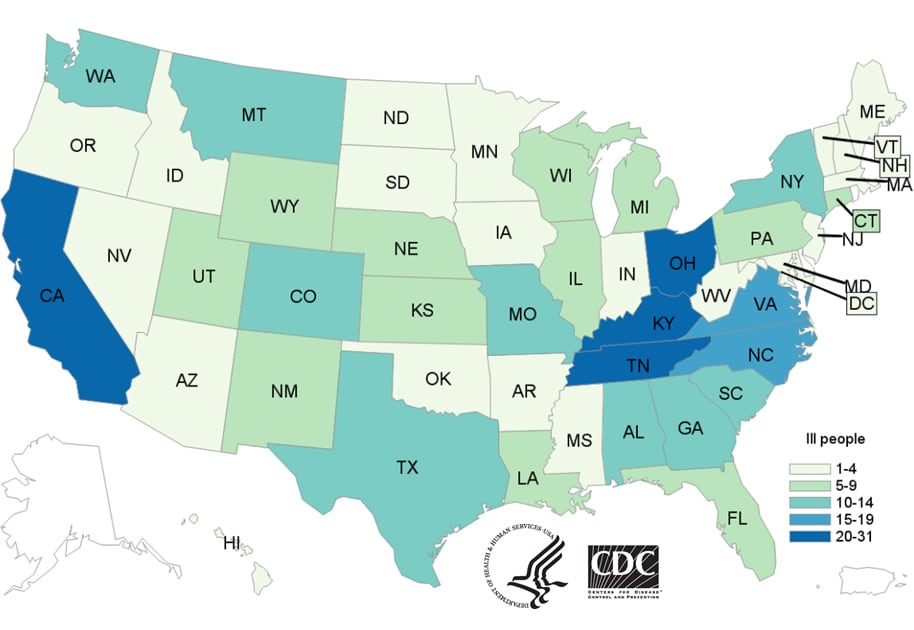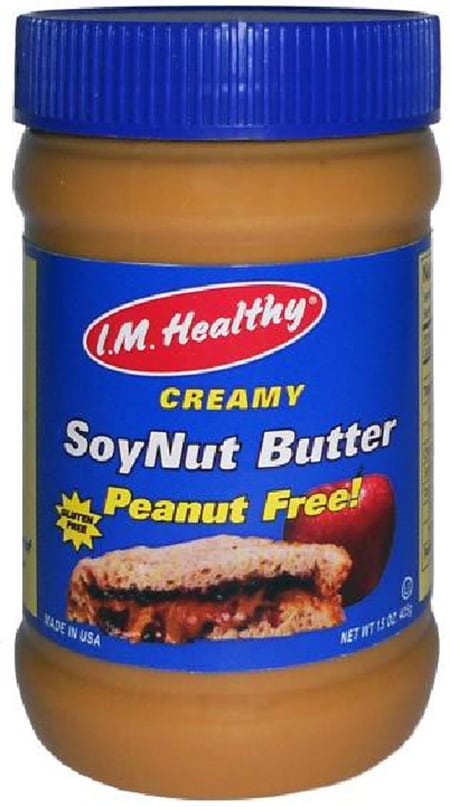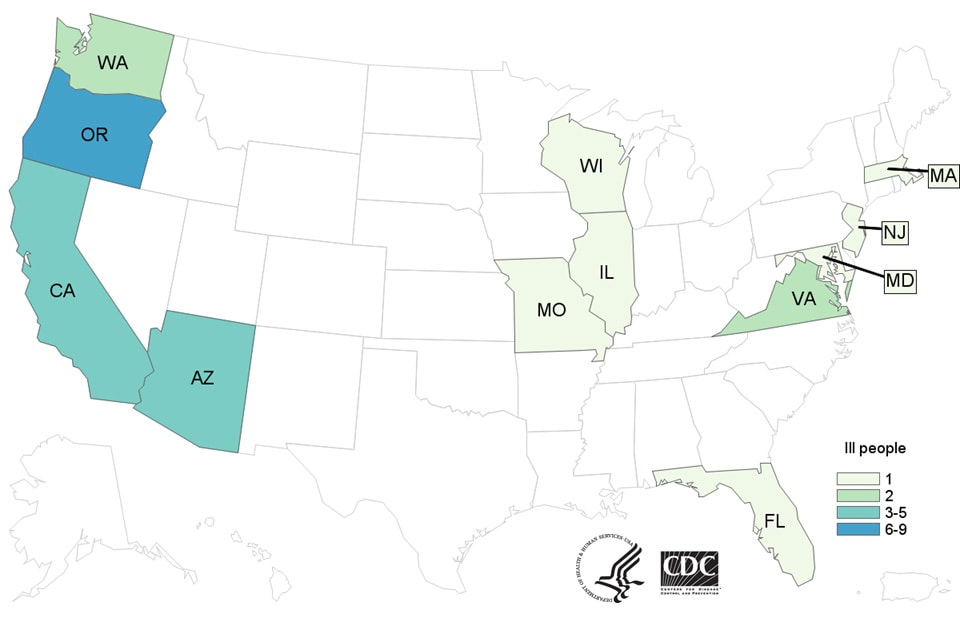Archive for the ‘Food-borne diseases’ Category
People infected with the outbreak strains of Salmonella, by state of residence, as of May 25, 2017 (n=372)
Friday, June 2nd, 2017
Posted June 1, 2017 2:45PM ET
Outbreak Advisory
| 8 Outbreaks |
372 Cases |
47 States |
71 Hospitalizations |
|---|
- CDC, many state departments of health and agriculture, and the U.S. Department of Agriculture’s Animal and Plant Health Inspection Service are investigating eight multistate outbreaks of human Salmonella infections linked to contact with live poultry in backyard flocks.
- These outbreaks are caused by several kinds of Salmonella bacteria: Salmonella Braenderup, Salmonella Enteritidis, Salmonella Hadar, Salmonella I 4,[5],12:i-, Salmonella Indiana, Salmonella Infantis, Salmonella Mbandaka, and Salmonella Typhimurium.
- As of May 25, 2017, 372 people infected with the outbreak strains of Salmonella have been reported from 47 states.
- Illnesses started on dates ranging from January 4, 2017 to May 13, 2017.
- 71 ill people have been hospitalized, and no deaths have been reported.
- 36% of ill people are children younger than 5 years.
- Epidemiologic, traceback, and laboratory findings link the eight outbreaks to contact with live poultry, such as chicks and ducklings, which come from several hatcheries.
- In interviews, 190 (83%) of 228 ill people reported contact with live poultry in the week before illness started.
- People reported purchasing live baby poultry from several sources, including feed supply stores, websites, hatcheries, and from relatives.
- Contact with live poultry and the areas where they live and roam can make people sick with Salmonella infections. Chicks, ducklings, and other live poultry that look healthy and clean can still carry Salmonella bacteria.
- Outbreaks(https://www.cdc.gov/eid/article/22/10/15-0765_article) linked to contact with live poultry have increased in recent years as more people keep backyard flocks. In 2016(https://www.cdc.gov/salmonella/live-poultry-05-16/), a record number of illnesses were linked to contact with backyard poultry.
CDC: Unpasteurized milk, consumed by only 3.2% of the population, and cheese, consumed by only 1.6% of the population, caused 96% of illnesses caused by contaminated dairy products.
Thursday, May 11th, 2017Costard S, Espejo L, Groenendaal H, Zagmutt FJ. Outbreak-related disease burden associated with consumption of unpasteurized cow’s milk and cheese, United States, 2009–2014. Emerg Infect Dis. 2017 Jun [date cited]. https://dx.doi.org/10.3201/eid2306.151603
A dodgy batch of smelly French cheese has been blamed for a 300-student mass food poisoning outbreak at schools in Normandy.
Tuesday, May 9th, 2017“…..The children began to suffer headaches, vomiting and stomach aches after eating the cheese at 54 different primary schools and nurseries on 27 April…..”
Multistate Outbreak of Shiga toxin-producing Escherichia coli O157:H7 Infections Linked to I.M. Healthy Brand SoyNut Butter
Friday, March 31st, 2017At least 435 students fell ill of suspected food poisoning in public schools across Egypt on Tuesday and Wednesday after consuming government-issued school meals.
Saturday, March 25th, 2017“…..Egypt’s Health Ministry announced on Wednesday that 312 students in schools in Cairo, Suez and Aswan were hospitalized with symptoms of food poisoning, in a succession of mass food poisoning incidents that started earlier this month caused by the school meals, produced by a military-owned company. Some 2,200 students were treated last week for the same symptoms in the southern province of Sohag.
The manager of Beni Suef’s central hospital, Mohamed el-Gebaly, told The Associated Press that 25 students from the province south of Cairo are in stable condition and being treated for vomiting and stomach pain……”
Egypt saw 4,650 suspected food poisoning cases in schools nationwide in March alone.
Saturday, March 25th, 2017“…..In a single incident last week in the southern city of Sohag, at least 3,353 students were affected. Similar outbreaks have taken place this week in other governorates, though on a much smaller scale, including in the canal city of Suez, Menoufiya in the Nile Delta and the southern city of Aswan…..Health Ministry official Amr Kandil said an investigation of school meals had detected no microbes linked to food poisoning…….”
Two people have died in a Danish outbreak of Salmonella that has infected at least 19 people.
Wednesday, March 22nd, 2017
“….Several of the outbreak victims reported having eaten a commercial frozen, microwaveable dinner consisting of meatloaf, potatoes and sauce….”
More than 3,300 children were hospitalized in Egypt on Tuesday after an outbreak of food poisoning at several state-run primary schools
Thursday, March 16th, 2017“…..A total of 3,353 children became ill, and at least 50 ambulances were sent to the schools, state news media said. Since then, all but 17 of the students have recovered and been discharged. No deaths or serious complications were reported…..”
Egypt’s Health Ministry says 2 262 schoolchildren have been admitted to hospital in a suspected mass food poisoning this week from 8 schools in the southern province of Sohag
Thursday, March 16th, 2017“….most of those admitted to hospital have been released. Samples of the meals were being analyzed to ascertain the cause of the suspected poisoning………[T]he Sohag governor suspended the food program pending the outcome of the analysis…..”
CDC: Multistate STEC O157:H7 outbreak tied to nut butter
Saturday, March 4th, 2017
Highlights
- CDC, multiple states, and the U.S. Food and Drug Administration (FDA) are investigating a multistate outbreak of Shiga toxin-producing Escherichia coli(https://www.cdc.gov/ecoli/general/index.html) O157:H7 (STEC O157:H7) infections.
- Twelve people infected with the outbreak strain of STEC O157:H7 have been reported from five states.
- Six ill people have been hospitalized. Four people developed hemolytic uremic syndrome, a type of kidney failure, and no deaths have been reported.
- Eleven of the 12 ill people in this outbreak are younger than 18 years old.
- Epidemiologic evidence available at this time indicates that I.M. Healthy brand SoyNut Butter is a likely source of this outbreak. I.M. Healthy brand SoyNut Butter may be contaminated with E. coli O157:H7 and could make people sick.
- CDC recommends that consumers do not eat, and childcare centers, schools, and other institutions do not serve, any I.M. Healthy brand SoyNut Butter varieties and sizes, or I.M. Healthy brand granola coated with SoyNut Butter.
- Even if some of the SoyNut Butter or granola was eaten or served and no one got sick, throw the rest of the product away. Put it in a sealed bag in the trash so that children, pets, or other animals can’t eat it.
- This investigation is ongoing and quickly changing. CDC will provide updates as more information becomes available.








